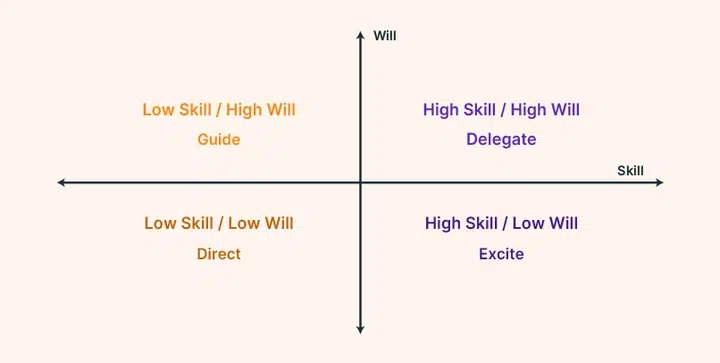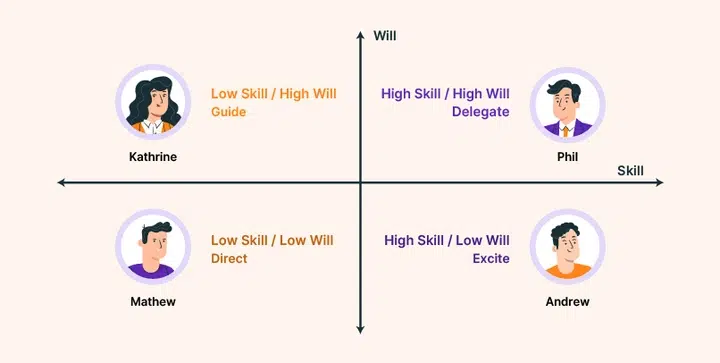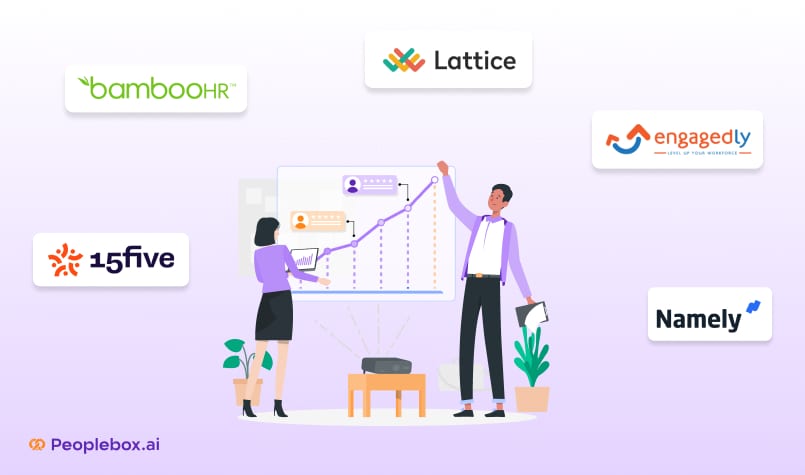The Skill Will Matrix reveals an uncomfortable truth many managers face: your top performers aren’t always delivering their best work, and it’s probably not due to lack of ability.
Picture Sarah, a talented developer on your team who’s been turning in increasingly mediocre code. Her skills haven’t diminished – she’s still brilliant – but something’s clearly off. Now multiply this scenario across your entire team, where different employees show varying levels of both capability and motivation.
This is where the Skill Will Matrix can help you get to the heart of the issue.
It’s a simple framework that plots each team member’s skill level against their motivation. By doing so, you can easily spot when someone’s performance is being impacted not by their ability, but by their engagement or willingness to take on challenges.
Using the Skill Will Matrix helps you move beyond the guesswork of performance management. You can now pinpoint whether performance issues are driven by a lack of skill or low motivation—and create strategies tailored to each individual.
By mapping your team members’ skill levels against their willingness to perform, you can finally move past the frustration of watching capable employees underperform and develop targeted strategies to unlock their full potential.
In this guide, we’ll show you how to use the Skill Will Matrix to diagnose performance gaps and implement targeted strategies that will bring out the best in every team member.

What is the Skill Will Matrix and Why is it Important for You?
Imagine you’re trying to lead a team through a challenging project. Some employees seem eager but lack the know-how, while others have all the expertise but none of the enthusiasm. This is where the Skill Will Matrix becomes your secret weapon—a simple yet powerful visual tool designed to help managers adapt their approach to the unique needs of each employee.
At its core, the Skill Will Matrix maps two critical factors: Skill (how capable someone is) and Will (how motivated they are). These are plotted on a 2×2 grid, with Skill on the horizontal axis and Will on the vertical axis.
Each quadrant represents a unique combination of skill and will, which, in turn, highlights the management style that a manager has to adopt for an employee to complete the task successfully.
For example:
- High Skill, Low Will: These are your seasoned experts who, despite their proficiency, appear disengaged or unmotivated. They need a manager who can reignite their passion, perhaps through meaningful challenges, recognition, or connecting their work to a bigger purpose.
- Low Skill, High Will: These enthusiastic learners are bursting with motivation but lack the expertise to execute tasks effectively. They thrive under supportive leadership focused on coaching, skill-building, and offering clear, constructive feedback.
- Low Skill, Low Will: Employees in this quadrant require careful attention. They may need basic training, consistent encouragement, or, in some cases, candid conversations about their role, goals, and alignment with the organization.
- High Skill, High Will: These are your dream team members—high-performing and self-driven individuals who excel when given trust, autonomy, and opportunities to lead or innovate.
This tool isn’t just theoretical—it’s inspired by the Situational Leadership Model developed by Paul Hersey and Ken Blanchard in the 1970s, proving its timeless relevance.

Skill vs. Will: What Sets Them Apart?
When managing a team, understanding the distinction between skill and will is key to unlocking true potential. Here are all the major differences between the two axes – skill and will:
| Aspect | Skill | Will |
| Definition | How competent an employee is in their role. | How motivated an employee is to perform their role well. |
| Ease of measuring | Easy to measure as it can be evaluated objectively. | More difficult to measure as it is subjective. |
| How it is acquired | Some skills are acquired naturally, while others are honed over time. | Will is usually acquired by the employee’s professional experience, incentives, and professional goals. |
| Nature | Usually remains intact for a long time. | Might fluctuate based on the personal life and the confidence of the employees. |
| Example | A sales executive with strong negotiation and communication abilities. | A motivated digital marketer eager to learn and take on new challenges. |
So, now you know that skill lays the groundwork for capability, while will fuels the drive to excel. Together, they shape the foundation of employee performance.
By addressing both dimensions—whether through targeted upskilling or reigniting motivation—you can build a team that’s not just competent but also inspired to deliver their best.
The Four Employee Types in the Skill-Will Matrix Quadrants
Let’s break down each quadrant of the Skill-Will Matrix and explore exactly how to manage each type of employee:
🌟 Empowered Experts (High Skill, High Will)
Who they are: These are your dream team members – highly capable and deeply motivated. Think of the senior developer who not only delivers exceptional code but also enthusiastically mentors juniors and proposes innovative solutions.
Your Management Approach: DELEGATE
- Give them challenging, high-impact projects
- Create opportunities for them to lead initiatives
- Provide autonomy while remaining available for strategic guidance
- Position them as internal mentors and future leaders
📈 Aspiring Achievers (High Will, Low Skill)
Who they are: These employees bring enthusiasm and eagerness but need technical development. Imagine a junior analyst who’s first to volunteer for projects but still learning the essential skills.
Your Management Approach: GUIDE
- Create structured learning paths
- Pair them with experienced mentors
- Provide regular feedback and coaching
- Break complex tasks into manageable learning opportunities
💭 Skilled but Disengaged (High Skill, Low Will)
Who they are: These team members have mastered their craft but lost their spark. Like Sarah, the brilliant developer whose code quality has dropped despite her capabilities.
Your Management Approach: EXCITE
- Have honest conversations about career aspirations
- Find new challenges that align with their interests
- Consider role modifications or special projects
- Recognize and reward progress to rebuild motivation
🎯 Guided Learners (Low Skill, Low Will)
Who they are: These team members are struggling on both fronts, but don’t write them off yet. Struggling with both ability and motivation, they may need deeper support. It could be a matter of misaligned roles or untapped potential waiting to surface.
Your Management Approach: DIRECT
- Set clear, achievable goals with specific timelines
- Provide structured training and frequent check-ins
- Investigate root causes of disengagement
- Consider role realignment if skills and interests don’t match the current position
Remember: No quadrant is permanent. With the right management approach, employees can and do move between quadrants. The key is identifying where each team member currently sits and applying the appropriate strategy to help them reach their full potential.
Example of Skill Will Matrix
Nina has recently joined XYZ as senior HR manager and is managing 4 HR professionals:
- Phil – has been on the team for five years as a recruiter.
- Kathrine – has been on the team for eight years as an HR generalist.
- Andrew – has been on the team for six months as a payroll officer.
- Mathew – has been on the team for three years as HR coordinator.
After two months of observations, one-on-ones, and performance reviews, she mapped her four team members using the Skill-Will Matrix. Here’s what she discovered and how she acted:

1 High Skill, High Will: Phil, The Rising Star
Phil, a five-year veteran recruiter, showed both strong capabilities and high motivation. Though previously passed over for a senior role due to experience gaps, his potential was clear. Nina’s solution? She gave him stretch assignments and mentoring opportunities, including shadowing her work to develop his leadership skills.
2 High Skill, Low Will: Kathrine, The Hidden Potential
Despite eight years of experience and impressive certifications, Kathrine, the HR generalist, was clearly uninspired. Nina identified a perfect growth opportunity – developing her into an HR Business Partner. By creating a clear 6-month development plan, Nina reignited Kathrine’s motivation and gave her a compelling career path.
3 High Will, Low Skill: Andrew, The Eager Learner
As a recent career switcher from marketing to payroll, Andrew brought enthusiasm but lacked technical expertise. Nina supported his growth with targeted training programs and created clear learning milestones. His positive attitude made him an ideal candidate for skill development.
4 Low Skill, Low Will: Mathew, The Mismatched Talent
When Mathew’s HR coordinator role showed consistently poor performance, Nina dug deeper. Their conversation revealed his true passion lay in sales. Instead of forcing a poor fit, Nina facilitated a potential transfer to the sales team – turning a performance problem into a career opportunity.
One thing is clear: The skill-will matrix isn’t just about categorizing employees – it’s about taking appropriate action to help each team member succeed, whether within their current role or in a better-fitting position.
Steps to Implement a Skill Will Matrix
Here is a structured approach to creating and implementing a Skill Will Matrix in your organization:
Step 1: Set Clear Benchmarks
- Write down 3-4 observable skills needed for each role
- Define what “high motivation” looks like in concrete behaviors
Example: For a developer, high skill = “Completes complex features with minimal bugs”; high will = “Voluntarily helps teammates debug issues”
Step 2: Conduct Your First Assessment
- Open your calendar and block 15 minutes per team member (Peoplebox.ai makes this super easy with its one-on-one feature, by the way)
- Create a simple spreadsheet with columns: Name, Skill Rating (1-3), Will Rating (1-3), Key Examples
- For each person, note:
- Their last 3 project outcomes
- Recent examples of initiative (or lack thereof)
- Areas where they’ve asked for help or shown growth
With Peoplebox.ai, you can access historical performance data, engagement scores, and project completion rates in one dashboard to make data-driven assessments. Give it a try!
Step 3: Get Outside Perspective
- Schedule a 30-minute coffee with a peer manager who knows your team
- Show them your ratings without explaining your reasoning
- Ask: “What examples would you add to support or challenge these ratings?”
- Revise your ratings based on this discussion
Step 4: Create Your Matrix
- Draw your matrix on a whiteboard or digital tool
- Place each team member in their quadrant
- Write one immediate action you can take for each person
Step 5: Design Individual Action Plans
For each quadrant, prepare specific next steps:
High Skill, High Will
- Assign them a strategic project
- Schedule monthly mentoring sessions
- Give them a team to lead
High Will, Low Skill
- Book specific training sessions
- Set up weekly skill-building exercises
- Assign a senior mentor
High Skill, Low Will
- Schedule a career discussion
- Identify new challenges or projects
- Create clear growth opportunities
Low Skill, Low Will
- Plan a frank discussion about role fit
- Set clear 30-60-90 day goals
- Consider role realignment options
Step 6: Have Growth Conversations
- Book 15-30 minutes with each team member
- Opening: “I’d like to discuss how we can best support your growth here”
- Core questions to ask:
- “What part of your role energizes you most?”
- “Where do you feel you need more support?”
- “What would help you perform at your best?”
Step 7: Set Review Cycles
- Set quarterly calendar reminders for matrix updates
- Create a simple tracking sheet:
- Initial position
- Actions taken
- Movement between quadrants
- Next steps
Peoplebox.ai lets you generate quarterly performance reviews automatically, comparing progress across teams and identifying emerging patterns in skill development and engagement.
Success Indicators:
- Every team member has a clear development plan within 30 days
- Matrix is updated quarterly
- Each person shows movement toward high skill/high will within 6 months
When to Use the Skill Will Matrix?
While a Skill Will Matrix is useful at all times, there are certain instances when it becomes extremely handy.

✅ When You Want To Restructure Teams Without Losing Top Talent
During organizational changes, use the matrix to protect and position your top talent effectively. Instead of making gut decisions, let the data guide you in placing the right people in the right roles. This approach keeps your high performers engaged while ensuring new team structures are balanced and effective.
✅ Get New Hires Up to Speed 2x Faster
The employee onboarding process can often get overwhelming. The Skill Will Matrix eases this to a considerable extent. It highlights areas where new hires lack skills or motivation. You can use this data to tailor onboarding plans and develop their skills or offer the necessary motivation to accelerate their integration.
✅ Turn Good Managers into Great Leaders
Help your managers become more strategic in their people development efforts. The matrix provides a clear framework for deciding when to coach, delegate, or provide additional training. This focused approach transforms good managers into exceptional leaders who drive team growth.
✅ Build Teams That Move Fast and Adapt Faster
Use the matrix to keep your teams agile. Identify who can lead change initiatives and who needs extra support during transitions. This ongoing assessment helps maintain team momentum even as business priorities shift.
✅ Fix Performance Issues That Won’t Go Away
When conventional performance management isn’t working, the matrix reveals deeper insights. By understanding whether the root cause is skill-related, motivation-based, or both, you can design interventions that actually stick.
Best Practices to Follow During Skill Will Matrix Implementation
Now that we’ve seen how a skill-will matrix can help you, here are some best practices you can follow to make the best out of it!
- Collect information from various inputs such as performance reviews, peer feedback, self-assessments, and surveys. This approach minimizes biases and provides a comprehensive view of both skills and motivation levels.
- Explain the purpose and process of the Skill Will Matrix to employees. Encourage them to see it as a development tool rather than a judgment. Provide ongoing support through regular feedback and actionable plans.
- Use the matrix to identify areas for growth and create tailored action plans. Avoid using it solely for categorization; instead, focus on enhancing employee performance and role outcomes.
- Look beyond individual assessments to understand how each person contributes to the team. Strong collaborators can boost overall team performance, even if they have lower skills but high motivation.
- Treat the Skill Will Matrix as a dynamic framework. Make sure that it evolves with changing circumstances. Reassess regularly to adapt to shifts in roles, skills, and motivation levels. It must remain relevant and effective throughout its existence.
How Can Peoplebox.ai Help Assess Skills?
Peoplebox.ai is an employee engagement platform designed to improve your employees’ performance. It provides a variety of features to streamline the evaluation of both the skills and will of your employees. Here’s how it can support you in skill assessment and tracking:
- Real-Time Feedback and Insights: Peoplebox.ai offers a centralized database for all performance-related information of employees. The data collected is based on feedback from multiple sources, including peers, managers, and even customers. This gives a 360-degree view of the employee’s ability and motivation to perform the role effectively.
- Goal-Tracking and Performance Metrics: Peoplebox.ai offers customizable dashboards for goal tracking and KPIs management. Managers can set measurable goals tied to both skill improvement and performance outcomes. This enables them to objectively evaluate an employee’s growth and track their progress in developing key skills over time.
- One-on-One Meeting: The platform facilitates structured one-on-one meetings, which is essential for discussing skill development and employee aspirations. Managers can also use these meetings to provide tailored feedback and set actionable goals for upskilling.
To know more about Peoplebox.ai and how it can help, book a demo now.







